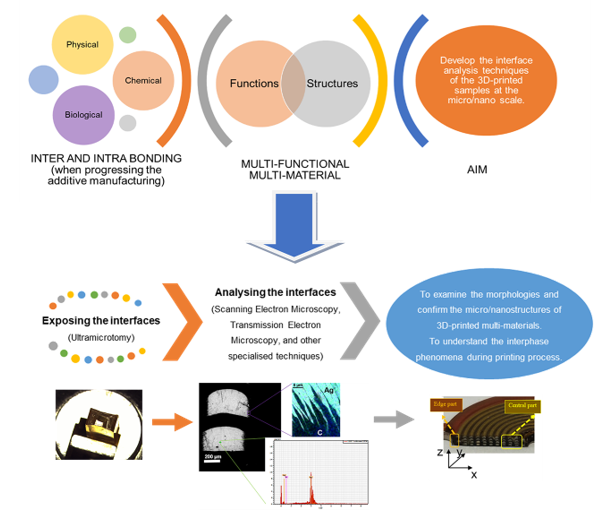Video Article Open Access
Interface Characterisation for the Next Generation of Multi-materials Additive Manufacturing
Tien Thuy Quach1,2,3,*, Gustavo F. Trindade1,2, Richard JM. Hague2, Clive J. Roberts1
1Advanced Materials and Healthcare Technologies, School of Pharmacy, University of Nottingham, Nottingham, NG7 2RD, the United Kingdom
2Centre for Additive Manufacturing, Faculty of Engineering, University of Nottingham, Nottingham, NG8 1BB, the United Kingdom
3Faculty of Pharmacy, Ho Chi Minh City University of Technology, Binh Thanh District, Ho Chi Minh City, Vietnam
Vid. Proc. Adv. Mater., Volume 2, Article ID 2108231 (2021)
DOI: 10.5185/vpoam.2021.08231
Publication Date (Web): 12 Sep 2022
Copyright © IAAM
Graphical Abstract

Abstract
Multi-materials additive manufacturing allows the combination of different materials within a printed object to facilitate new functionality and/or enhance the performance of the final product [1]. Applications are foreseen in wide-ranging fields including automotive, engineering, healthcare, aerospace, and defense, and we are endeavoring to produce co-printed functional multi-materials particularly in pharmaceuticals and electronics [2]. To achieve this, potential physicochemical incompatibility of materials when concurrently or sequentially printed that may limit the efficiency and affordability of the 3D-printing technology needs to be understood and addressed [3]. Currently, the School of Pharmacy and the Centre for Additive Manufacturing from the University of Nottingham have been collaborating with various partners to design and develop the methodologies for co-printing and characterising the 3D-printed multi-functional multi-materials such as organic-inorganic materials in printed electronics or supportive/active materials in pharmaceuticals. Our project belongs to the Research Challenge 1 of the Programme Grant “Enabling Next Generation of Additive Manufacturing” (NextGen AM) [4]. We aim to develop robust characterisation approaches to study at the micro and nano scale the material interfaces and interphases of multi-material 3D prints. In this first phase of the project, we will present work on the development of suitable sample-preparation strategies to expose native material interfaces from within 3D-printed objects. As an example, we show data related to a commercialised 3D-printed inductor device ("DragonFly system" from Nano Dimension Company [5]). Ultramicrotomy was shown to be able to expose undamaged interfaces suitable for analysis by Scanning Electron Microscopy (SEM), Atomic Force Microscopy (AFM), and Transmission Electron Microscopy (TEM) to acquire morphological and structural data of the 3D-printed samples. Fourier-Transform Infrared Spectroscopy (FT-IR Spectroscopy) and Time-of-Flight Secondary Ion Mass Spectrometry (ToF-SIMS) were also carried out to study interface composition and chemistry. We will show how the materials and chemical insights provided by these types of analysis can provide opportunities for improved multi-materials additive manufacturing and device functionalities.
Acknowledgement
Programme Grant “Enabling Next Generation Additive Manufacturing” (EP/P031684/1) for funding the project. The School of Pharmacy, Centre for Additive Manufacturing, Nano and Micro Scale Research Centre (nmRC) at the University of Nottingham for the necessary facilities. The Nano Dimension Company for providing the commercialised electromagnet product.
References
- A.H. Espera, J.R.C. Dizon, Q. Chen, R.C. Advincula; Progress in Additive Manufacturing, 2019, 4(3), 245-267.
- J. Y. Lee, J. An, C. K. Chua; Applied Materials Today, 2017, 7, 120-133.
- J. Plocher, A. Panesar; Materials and Design, 2019, 183, 108-164.
- https://www.nottingham.ac.uk/research/groups/cfam/major-epsrc-funding/index.aspx
- https://www.nano-di.com/3d-printing-applications-for-electromagnets
Video Proceedings of Advanced Materials

Upcoming Congress



